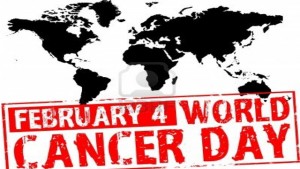 On Wednesday February 4th, the Federation of St. Kitts and Nevis joins the world health community in commemorating “World Cancer Day”. The theme is “Not beyond us” which signifies the fact that cancer is avoidable, preventable and potentially curable. A diagnosis of cancer is not a death sentence.
On Wednesday February 4th, the Federation of St. Kitts and Nevis joins the world health community in commemorating “World Cancer Day”. The theme is “Not beyond us” which signifies the fact that cancer is avoidable, preventable and potentially curable. A diagnosis of cancer is not a death sentence.
Cancer Facts (source: Health Information Unit)
• In the period 2011 – 2013, the average number of new cases was 85 which corresponds to a rate of 17 per 10, 000 inhabitants (global average 18), unchanged from 2007.
• The most common cancer sites in females are cervix and breast; in males, prostate.
• Over the past 5 years, there was an average of 60 cancer deaths per year or 12 deaths per 10, 000 inhabitants; equivalent to a global rank of 130 out of 192 countries (http://www.worldlifeexpectancy.com quoting WHO). Global high and low rates are 26 and 6, respectively.
• Similar to the wealthy nations of the world, cancer ranks in the top three leading disease causes of death after heart disease and stroke.
Cancer Risk Factors
Global cancer data from the World Health Organization indicate the following:
• Regarding new cases
o 90 to 95% are due to environmental factors with lifestyle being the most significant.
o 10% or less are due to inherited factors. Cancer is not about bad luck.
• Regarding cancer deaths
o 30% are due to the five (5) leading behavioural and dietary risks such as overweight and obesity (high body mass index), low fruit and vegetable intake, lack of physical activity, tobacco use, and alcohol use.
o 20% are caused by tobacco use
o 20% of cancer deaths in low- and middle-income countries are caused by viral infections such as Hepatitis B and C (liver cancer), and the Human Papilloma Virus (cervical cancer).
Cancer Avoidance, Protection & Prevention
Cervical cancer is directly linked to the human papilloma virus contracted during sexual intercourse. Avoidance is through abstention. Condoms provide effective protection. An effective preventive vaccine is available and is expected to be introduced to the Federation shortly. Screening tests are available free of charge in community health centers.
Breast cancer rates are lower females who breast feed, who are breast fed, who abstain from alcohol, and who have healthy weight for their height. Breast self-examination is easy to learn and perform.
Prostate cancer research has found a protective effect in a substance called lycopene. Rich natural sources are tomatoes, watermelon, guava, pink grapefruit, pawpaw, carrots, mango, red cabbage, and red peppers. Changes in prostate gland can be detected during a routine physical exam.
A cause of liver cancer is the Hepatitis B virus which is contracted during sexual intercourse and the use of contaminated needles by drug addicts. An effective vaccine is administered free of charge in community health centers.
Very low rates of cancer of the mouth, stomach, and intestines are found in persons who consume a plant-based diet comprised of green and root vegetables, fruits, and whole grain. A high rate is associated with excess intake of red meat, processed food and alcohol.
Cancer Treatment
Early detection increases the chance of cure. Treatment may involve surgery, medicine, chemotherapy or radiation therapy. All treatments except radiation are available in the Federation.
Key Messages
• Healthy lifestyles is the recipe for cancer protection and prevention.
• Cancer changes start in a single cell then spread to surrounding cells and tissues. Early detection is possible through the following services that are available Federation:
o Analysis (e.g. Pap smear) of the cervix available free in health centers.
o Lab analyses of blood cells and tissues.
o Physical examination of the prostate.
o Physical examination of the breast. The correct method is easy to learn.
o Radiologic Imaging such as plain x-rays, mammography, and CT-scan.
o Colonoscopy or endoscopic examination of the digestive tract at both hospitals.
o Colposcopy which is a procedure to directly exam the cervix.
• The risk of cancer is either prevented or reduced by following actions:
o Vaccination against Hepatitis B (a cause of liver cancer). Vaccine is available in health centers.
o Vaccination against Human Papilloma Virus (major cause of cervical cancer). Vaccine will soon be available in health centers.
o Maintaining body weight within the recommended range for height. Contact your nurse or doctor for Body Mass index calculations or go online for calculators.
o Engaging in any form of physical activity (e.g. walking, swimming, dancing) daily or at least three times per week.
o Avoiding, reducing or eliminating the consumption of energy-dense foods such as fast foods, oily food and snacks.
o Avoiding, reducing or eliminating added salt, red meat and processed meats such as sausage, pepperoni, and ham.
o Avoiding, reducing or eliminating the consumption of sugary drinks such as sodas and artificial juice drinks.
o Avoiding, reducing or eliminating the consumption of alcoholic drinks i.e. no more than 2 drinks per day in men and one drink per day in women. One drink contains 10 – 15 grams of alcohol.
o Adopting a plant-based diet consisting of ground provisions, vegetables, legumes, whole grains, and fruits.
o Use of condoms during sexual intercourse.
